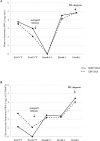γ-Herpesvirus load as surrogate marker of early death in HIV-1 lymphoma patients submitted to high dose chemotherapy and autologous peripheral blood stem cell transplantation
- PMID: 25668032
- PMCID: PMC4323102
- DOI: 10.1371/journal.pone.0116887
γ-Herpesvirus load as surrogate marker of early death in HIV-1 lymphoma patients submitted to high dose chemotherapy and autologous peripheral blood stem cell transplantation
Abstract
Autologous stem cell transplantation (ASCT) is a feasible procedure for human immunodeficiency virus-1 (HIV-1) lymphoma patients, whose underlying disease and intrinsic HIV-1- and ASCT-associated immunodeficiency might increase the risk for γ-herpesvirus load persistence and/or reactivation. We evaluated this hypothesis by investigating the levels of Epstein-Barr virus (EBV)- and Kaposi sarcoma-associated herpesvirus (KSHV)-DNA levels in the peripheral blood of 22 HIV-1-associated lymphoma patients during ASCT, highlighting their relationship with γ-herpesvirus lymphoma status, immunological parameters, and clinical events. EBV-DNA was detected in the pre-treatment plasma and peripheral blood mononuclear cells (PBMCs) of 12 (median 12,135 copies/mL) and 18 patients (median 417 copies/10(6) PBMCs), respectively; the values in the two compartments were correlated (r = 0.77, p = 0.0001). Only EBV-positive lymphomas showed detectable levels of plasma EBV-DNA. After debulking chemotherapy, plasma EBV-DNA was associated with lymphoma chemosensitivity (p = 0.03) and a significant higher mortality risk by multivariate Cox analysis adjusted for EBV-lymphoma status (HR, 10.46, 95% CI, 1.11-98.32, p = 0.04). After infusion, EBV-DNA was detectable in five EBV-positive lymphoma patients who died within six months. KSHV-DNA load was positive in only one patient, who died from primary effusion lymphoma. Fluctuations in levels of KSHV-DNA reflected the patient's therapy and evolution of his underlying lymphoma. Other γ-herpesvirus-associated malignancies, such as multicentric Castleman disease and Kaposi sarcoma, or end-organ complications after salvage treatment were not found. Overall, these findings suggest a prognostic and predictive value of EBV-DNA and KSHV-DNA, the monitoring of which could be a simple, complementary tool for the management of γ-herpesvirus-positive lymphomas in HIV-1 patients submitted to ASCT.
Conflict of interest statement
Figures


Similar articles
-
Predictive value of HIV type 1 DNA levels on overall survival in HIV-related lymphoma Patients treated with high-dose chemotherapy (HDC) plus autologous stem cell transplantation (ASCT).AIDS Res Hum Retroviruses. 2010 Feb;26(2):245-51. doi: 10.1089/aid.2009.0081. AIDS Res Hum Retroviruses. 2010. PMID: 20156109
-
Autograft HIV-DNA load predicts HIV-1 peripheral reservoir after stem cell transplantation for AIDS-related lymphoma patients.AIDS Res Hum Retroviruses. 2015 Jan;31(1):150-9. doi: 10.1089/aid.2014.0157. AIDS Res Hum Retroviruses. 2015. PMID: 25581618 Free PMC article.
-
Plasma Epstein-Barr Virus Load as an Early Biomarker and Prognostic Factor of Human Immunodeficiency Virus-related Lymphomas.Clin Infect Dis. 2019 Feb 15;68(5):834-843. doi: 10.1093/cid/ciy542. Clin Infect Dis. 2019. PMID: 29982484
-
HIV-associated lymphomas and gamma-herpesviruses.Blood. 2009 Feb 5;113(6):1213-24. doi: 10.1182/blood-2008-09-180315. Epub 2008 Oct 27. Blood. 2009. PMID: 18955561 Review.
-
Lymphomas occurring specifically in HIV-infected patients: from pathogenesis to pathology.Semin Cancer Biol. 2013 Dec;23(6):457-67. doi: 10.1016/j.semcancer.2013.08.004. Epub 2013 Aug 30. Semin Cancer Biol. 2013. PMID: 23999127 Review.
Cited by
-
Role of HIV-1 matrix protein p17 variants in lymphoma pathogenesis.Proc Natl Acad Sci U S A. 2015 Nov 17;112(46):14331-6. doi: 10.1073/pnas.1514748112. Epub 2015 Nov 2. Proc Natl Acad Sci U S A. 2015. PMID: 26578780 Free PMC article. Clinical Trial.
-
Biological Predictors of De Novo Tumors in Solid Organ Transplanted Patients During Oncological Surveillance: Potential Role of Circulating TERT mRNA.Front Oncol. 2021 Oct 21;11:772348. doi: 10.3389/fonc.2021.772348. eCollection 2021. Front Oncol. 2021. PMID: 34746013 Free PMC article.
-
[Autologous hematopoietic stem cell transplantation for human immunodeficiency virus related lymphoma: a case report and literatures review].Zhonghua Xue Ye Xue Za Zhi. 2018 Jan 14;39(1):66-68. doi: 10.3760/cma.j.issn.0253-2727.2018.01.016. Zhonghua Xue Ye Xue Za Zhi. 2018. PMID: 29551039 Free PMC article. Chinese. No abstract available.
-
Oral shedding of herpesviruses in HIV-infected patients with varying degrees of immune status.AIDS. 2017 Sep 24;31(15):2077-2084. doi: 10.1097/QAD.0000000000001589. AIDS. 2017. PMID: 28723706 Free PMC article.
References
-
- Stevens SJ, Smits PH, Verkuijlen SA, Rockx DA, van Gorp EC, et al. (2007) Aberrant Epstein-Barr virus persistence in HIV carriers is characterized by anti-Epstein-Barr virus IgA and high cellular viral loads with restricted transcription. AIDS 21:2141–9. - PubMed
-
- Van Esser JW, van der Holt B, Meijer E, Niesters HG, Trenschel R, et al. (2001) Epstein-Barr virus (EBV) reactivation is a frequent event after allogeneic stem cell transplantation (SCT) and quantitatively predicts EBV-lymphoproliferative disease following T-cell—depleted SCT. Blood 98:972–8. - PubMed
-
- Juvonen E, Aalto S, Tarkkanen J, Volin L, Hedman K, et al. (2007) Retrospective evaluation of serum Epstein Barr virus DNA levels in 406 allogeneic stem cell transplant patients. Haematologica 92:819–25. - PubMed
Publication types
MeSH terms
Substances
LinkOut - more resources
Full Text Sources
Other Literature Sources

